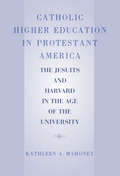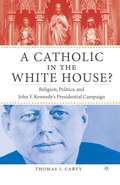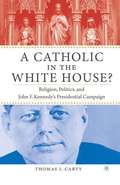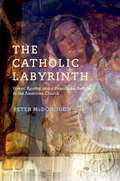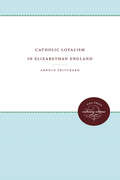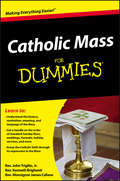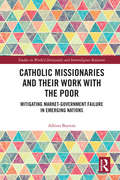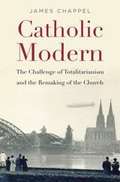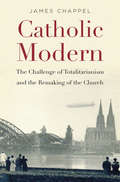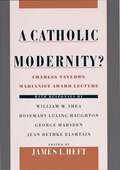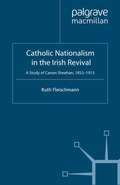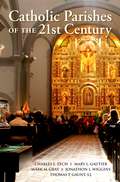- Table View
- List View
Catholic High Schools: Facing the New Realities
by James L. HeftCatholic high schools in the United States have been undergoing three major changes: the shift to primarily lay leadership and teachers; the transition to a more consumerist and pluralist culture; and the increasing diversity of students attending Catholic high schools. James Heft argues that to navigate these changes successfully, leaders of Catholic education need to inform lay teachers more thoroughly, conduct a more profound social analysis of the culture, and address the real needs of students. After presenting the history of Catholic schools in the United States and describing the major legal decisions that have influenced their evolution, Heft describes the distinctive and compelling mission of a Catholic high school. Two chapters are devoted to leadership, and other chapters to teachers, students, alternative models of high schools, financing, and the key role of parents, who today may be described as ''post-deferential'' to traditional authorities, including bishops and priests. Written by an award-winning teacher, scholar, and recognized educational leader in Catholic education, Catholic High Schools should be read by everyone interested in religiously- affiliated educational institutions, particularly Catholic education.
Catholic High Schools: Facing the New Realities
by James L. HeftCatholic high schools in the United States have been undergoing three major changes: the shift to primarily lay leadership and teachers; the transition to a more consumerist and pluralist culture; and the increasing diversity of students attending Catholic high schools. James Heft argues that to navigate these changes successfully, leaders of Catholic education need to inform lay teachers more thoroughly, conduct a more profound social analysis of the culture, and address the real needs of students. After presenting the history of Catholic schools in the United States and describing the major legal decisions that have influenced their evolution, Heft describes the distinctive and compelling mission of a Catholic high school. Two chapters are devoted to leadership, and other chapters to teachers, students, alternative models of high schools, financing, and the key role of parents, who today may be described as ''post-deferential'' to traditional authorities, including bishops and priests. Written by an award-winning teacher, scholar, and recognized educational leader in Catholic education, Catholic High Schools should be read by everyone interested in religiously- affiliated educational institutions, particularly Catholic education.
Catholic Higher Education: A Culture in Crisis
by Melanie M. Morey John J. PideritCatholic higher education in the United States is undergoing dramatic changes, driven largely by the virtual disappearance of nuns, brothers, and priests from Catholic university campuses. Today Catholic colleges and universities are dealing with critical questions about what constitutes Catholic collegiate identity. What are appropriate ways to engage the Catholic tradition across all sectors of university life? What constitutes a critical mass of committed and knowledgeable Catholics necessary to maintain religious identity? What is an appropriate level of knowledge and religious commitment for those who lead, govern, and teach at Catholic institutions and how do they acquire it? Many people have strong - and strongly differing - opinions about the current state of Catholic higher education. Melanie M. Morey and John J. Piderit, S.J., wade into these waters with a study of 124 senior administrators at 33 Catholic colleges and universities across the United States. Exceptionally candid appraisals by administrators across a varied landscape attest that a cultural crisis is looming at a number of Catholic institutions. Based on their research, Morey and Piderit describe the present situation and offer concrete suggestions for enhancing Catholic identity, culture, and mission at all Catholic colleges and universities. The authors define the critical issues and analyze and address them by using the rich construct of culture, particularly organizational culture. They provide four different models of how Catholic colleges and universities can operate and successfully compete as religiously distinctive institutions in the higher education market. After identifying the content of the Catholic tradition - intellectual, moral, and social - the authors analyze present performance among institutions in all four models. They derive criteria for identifying religious cultural crisis at institutions and provide specific policy proposals for enhancing religious culture. They also suggest principles for effectively leading and managing cultural change. Morey and Piderit offer the first in-depth cultural analysis of the Catholic character of Catholic universities and colleges at a crucial time for these institutions. With new research and practical applications, this book is an invaluable resource for Catholic educators and anyone concerned about the future of Catholic higher education.
Catholic Higher Education: A Culture in Crisis
by Melanie M. Morey John J. PideritCatholic higher education in the United States is undergoing dramatic changes, driven largely by the virtual disappearance of nuns, brothers, and priests from Catholic university campuses. Today Catholic colleges and universities are dealing with critical questions about what constitutes Catholic collegiate identity. What are appropriate ways to engage the Catholic tradition across all sectors of university life? What constitutes a critical mass of committed and knowledgeable Catholics necessary to maintain religious identity? What is an appropriate level of knowledge and religious commitment for those who lead, govern, and teach at Catholic institutions and how do they acquire it? Many people have strong - and strongly differing - opinions about the current state of Catholic higher education. Melanie M. Morey and John J. Piderit, S.J., wade into these waters with a study of 124 senior administrators at 33 Catholic colleges and universities across the United States. Exceptionally candid appraisals by administrators across a varied landscape attest that a cultural crisis is looming at a number of Catholic institutions. Based on their research, Morey and Piderit describe the present situation and offer concrete suggestions for enhancing Catholic identity, culture, and mission at all Catholic colleges and universities. The authors define the critical issues and analyze and address them by using the rich construct of culture, particularly organizational culture. They provide four different models of how Catholic colleges and universities can operate and successfully compete as religiously distinctive institutions in the higher education market. After identifying the content of the Catholic tradition - intellectual, moral, and social - the authors analyze present performance among institutions in all four models. They derive criteria for identifying religious cultural crisis at institutions and provide specific policy proposals for enhancing religious culture. They also suggest principles for effectively leading and managing cultural change. Morey and Piderit offer the first in-depth cultural analysis of the Catholic character of Catholic universities and colleges at a crucial time for these institutions. With new research and practical applications, this book is an invaluable resource for Catholic educators and anyone concerned about the future of Catholic higher education.
Catholic Higher Education in Protestant America: The Jesuits and Harvard in the Age of the University
by Kathleen A. MahoneyIn 1893 Harvard University president Charles W. Eliot, the father of the modern university, helped implement a policy that, in effect, barred graduates of Jesuit colleges from regular admission to Harvard Law School. The resulting controversy—bitterly contentious and widely publicized—was a defining moment in the history of American Catholic education, illuminating on whose terms and on what basis Catholics and Catholic colleges would participate in higher education in the twentieth century.In Catholic Higher Education in Protestant America, Kathleen Mahoney considers the challenges faced by Catholics as the age of the university opened. She describes how liberal Protestant educators such as Eliot linked the modern university with the cause of a Protestant America and how Catholic students and educators variously resisted, accommodated, or embraced Protestant-inspired educational reforms. Drawing on social theories of cultural hegemony and insider-outsider roles, Mahoney traces the rise of the Law School controversy to the interplay of three powerful forces: the emergence of the liberal, nonsectarian research university; the development of a Catholic middle class whose aspirations included attendance at such institutions; and the Catholic church's increasingly strident campaign against modernism and, by extension, the intellectual foundations of modern academic life.
A Catholic in the White House?: Religion, Politics, and John F. Kennedy's Presidential Campaign
by T. CartyAccording to most political and religious scholars and pundits, JFK's victory in 1960 symbolized America's evolution from a Protestant nation to a pluralist community that included Catholics as all citizens. However, if the presidential election of 1960 was indeed a turning point for American Catholics, how do we explain the failure of any Catholic - in over forty years - to repeat Kennedy's accomplishment? In this exhaustively researched study that fuses political, cultural, social and intellectual history, Thomas Carty challenges the assumption that JFK's successful campaign for the Presidency ended decades, if not centuries, of religious and political tension between American Catholics and Protestants, paving a new role for Catholics in American presidential politics.
A Catholic in the White House?: Religion, Politics, and John F. Kennedy's Presidential Campaign (PDF)
by Thomas J. CartyAccording to numerous scholars and pundits, JFK's victory in 1960 symbolized America's evolution from a politically Protestant nation to a pluralistic one. The anti-Catholic prejudice that many blamed for presidential candidate Alfred E. Smith's crushing defeat in 1928 at last seemed to have been overcome. However, if the presidential election of 1960 was indeed a turning point for American Catholics, how do we explain the failure of any Catholic--in over forty years--to repeat Kennedy's accomplishment? In this exhaustively researched study that fuses political, cultural, social, and intellectual history, Thomas Carty challenges the assumption that JFK's successful campaign for the presidency ended decades, if not centuries, of religious and political tensions between American Catholics and Protestants.
The Catholic Labyrinth: Power, Apathy, and a Passion for Reform in the American Church
by Peter McDonoughSexual abuse scandals, declining attendance, a meltdown in the number of priests and nuns, the closing of many parishes and parochial schools--all have shaken American Catholicism. Yet conservatives have increasingly dominated the church hierarchy. In The Catholic Labyrinth, Peter McDonough tells a tale of multiple struggles that animate various groups--the Survivors Network of those Abused by Priests, Voice of the Faithful, and the Leadership Roundtable chief among them--pushing to modernize the church. One contest pits reformers against those who back age-old standards of sexual behavior and gender roles. Another area of contention, involving efforts to maintain the church's far-flung operations in education, social services, and healthcare, raises constitutional issues about the separation of church and state. Once a sidebar to this debate, the bishops' campaign to control the terms of employment and access to contraceptives in church-sponsored ministries has fueled conflict further. McDonough draws on behind-the-scenes documentation and personal interviews with leading reformers and "loyalists" to explore how both retrenchment and resistance to clericalism have played out in American Catholicism. Despite growing support for optional celibacy among priests, the ordination of women, and similar changes, and in the midst of numerous departures from the church, immigration and a lingering reaction against the upheavals of the sixties have helped sustain a popular traditionalism among "Catholics in the pews." So have the polemics of Catholic neoconservatives. These demographic and cultural factors--as well as the silent dissent of those who simply ignore rather than oppose the church's more regressive positions--have reinforced a culture of deference that impedes reform. At the same time, selective managerial improvements show promise of advancing incremental change. Timely and incisive, The Catholic Labyrinth captures the church at a historical crossroads, as advocates for change struggle to reconcile religious mores with the challenges of modernity.
The Catholic Labyrinth: Power, Apathy, and a Passion for Reform in the American Church
by Peter McDonoughSexual abuse scandals, declining attendance, a meltdown in the number of priests and nuns, the closing of many parishes and parochial schools--all have shaken American Catholicism. Yet conservatives have increasingly dominated the church hierarchy. In The Catholic Labyrinth, Peter McDonough tells a tale of multiple struggles that animate various groups--the Survivors Network of those Abused by Priests, Voice of the Faithful, and the Leadership Roundtable chief among them--pushing to modernize the church. One contest pits reformers against those who back age-old standards of sexual behavior and gender roles. Another area of contention, involving efforts to maintain the church's far-flung operations in education, social services, and healthcare, raises constitutional issues about the separation of church and state. Once a sidebar to this debate, the bishops' campaign to control the terms of employment and access to contraceptives in church-sponsored ministries has fueled conflict further. McDonough draws on behind-the-scenes documentation and personal interviews with leading reformers and "loyalists" to explore how both retrenchment and resistance to clericalism have played out in American Catholicism. Despite growing support for optional celibacy among priests, the ordination of women, and similar changes, and in the midst of numerous departures from the church, immigration and a lingering reaction against the upheavals of the sixties have helped sustain a popular traditionalism among "Catholics in the pews." So have the polemics of Catholic neoconservatives. These demographic and cultural factors--as well as the silent dissent of those who simply ignore rather than oppose the church's more regressive positions--have reinforced a culture of deference that impedes reform. At the same time, selective managerial improvements show promise of advancing incremental change. Timely and incisive, The Catholic Labyrinth captures the church at a historical crossroads, as advocates for change struggle to reconcile religious mores with the challenges of modernity.
Catholic Loyalism in Elizabethan England (PDF)
by Arnold PritchardAlthough the varying attitudes toward the English crown and the order of English society were central to the differences between the loyalists and the militants, disagreements involved many questions other than political ones, including the role of the Jesuits in the English mission and the nature of church government. This first work to concentrate on the Elizabethan Catholic church relates party thought to the quarrels with the Catholic community during Elizabeth's reign.
Catholic Mass For Dummies
by Rev. John Trigilio Jr. Rev. Kenneth Brighenti Rev. Monsignor James CafoneAn unintimidating guide to understanding the Catholic Mass Throughout the centuries, the liturgy of the Church has taken a variety of regional and historical forms, but one thing has remained constant: the Mass has always been the central form of Catholic worship. Catholic Mass For Dummies gives you a step-by-step overview of the Catholic Mass, as well as a close look at the history and meaning of the Mass as a central form of Catholic worship. You'll find information on the order of a Mass and coverage of major Masses. Covers standard Sunday Mass, weddings, funerals, holiday services, and holy days of obligation Provides insight on the events, symbols, themes, history, and language of the Mass Translations of a Mass in Castilian and Latin American Spanish If you're a Catholic looking to enhance your knowledge of your faith, an adult studying to convert to Catholicism, a CCD instructor, or a non-Catholic who wants to understand the many nuances of the Catholic Mass, this hands-on, friendly guide has you covered.
Catholic Mass For Dummies
by Rev. John Trigilio Jr. Rev. Kenneth Brighenti Rev. Monsignor James CafoneAn unintimidating guide to understanding the Catholic Mass Throughout the centuries, the liturgy of the Church has taken a variety of regional and historical forms, but one thing has remained constant: the Mass has always been the central form of Catholic worship. Catholic Mass For Dummies gives you a step-by-step overview of the Catholic Mass, as well as a close look at the history and meaning of the Mass as a central form of Catholic worship. You'll find information on the order of a Mass and coverage of major Masses. Covers standard Sunday Mass, weddings, funerals, holiday services, and holy days of obligation Provides insight on the events, symbols, themes, history, and language of the Mass Translations of a Mass in Castilian and Latin American Spanish If you're a Catholic looking to enhance your knowledge of your faith, an adult studying to convert to Catholicism, a CCD instructor, or a non-Catholic who wants to understand the many nuances of the Catholic Mass, this hands-on, friendly guide has you covered.
Catholic Matters: Confusion, Controversy, and the Splendor of Truth
by Richard John NeuhausIn Catholic Matters, Father Neuhaus addresses the many controversies that have marked recent decades of American Catholicism. Looking beyond these troubles to "the splendor of truth” that constitutes the Church, he proposes a forward-thinking way of being Catholic in America. Drawing on his personal encounters with the late John Paul II and Cardinal Joseph Ratzinger, now Pope Benedict XVI, Neuhaus describes their hope for a springtime of world evangelization, Christian unity, and Catholic renewal. Catholic Matters reveals a vibrant Church, strengthened and unified by hardship and on the cusp of a great revival in spiritual vitality and an even greater contribution to our common life.
Catholic Missionaries and Their Work with the Poor: Mitigating Market-Government Failure in Emerging Nations (Studies in World Christianity and Interreligious Relations)
by Albino BarreraThis book explores the vital role of faith-based organizations (FBOs) in compensating for the market’s and government’s inability to provide vital services. Its key theoretical contribution is the notion that poverty is the result of a triadic failure—when markets, government, and civil society become dysfunctional at the same time. Using data on Catholic missionaries’ development work, this study presents the various ways by which FBOs mitigate market and government failures in healthcare, education, and social services, and in the process build and strengthen civil society. This study has two main objectives. First, it aims to present an overview of missionaries’ development work, evaluating the socioeconomic significance of their faith-based development work. In addition, various comparative advantages and disadvantages have been imputed to FBOs in the religion-development literature, and we assess to what extent missionaries actually exhibit these posited qualities in practice. Second, the groundwork is laid for future religion-development scholars by presenting a theoretical framework and a method for evaluating the role and contributions of FBOs in the larger community. This is an important investigation of contemporary worldwide Christianity and its relationship with development. As such, it will interest scholars of religious studies and missiology, as well as development economics, public service and the political economy.
Catholic Missionaries and Their Work with the Poor: Mitigating Market-Government Failure in Emerging Nations (Studies in World Christianity and Interreligious Relations)
by Albino BarreraThis book explores the vital role of faith-based organizations (FBOs) in compensating for the market’s and government’s inability to provide vital services. Its key theoretical contribution is the notion that poverty is the result of a triadic failure—when markets, government, and civil society become dysfunctional at the same time. Using data on Catholic missionaries’ development work, this study presents the various ways by which FBOs mitigate market and government failures in healthcare, education, and social services, and in the process build and strengthen civil society. This study has two main objectives. First, it aims to present an overview of missionaries’ development work, evaluating the socioeconomic significance of their faith-based development work. In addition, various comparative advantages and disadvantages have been imputed to FBOs in the religion-development literature, and we assess to what extent missionaries actually exhibit these posited qualities in practice. Second, the groundwork is laid for future religion-development scholars by presenting a theoretical framework and a method for evaluating the role and contributions of FBOs in the larger community. This is an important investigation of contemporary worldwide Christianity and its relationship with development. As such, it will interest scholars of religious studies and missiology, as well as development economics, public service and the political economy.
Catholic Missionaries in Early Modern Asia: Patterns of Localization (Religious Cultures in the Early Modern World)
by Nadine Amsler Andreea Badea Bernard Heyberger Christian WindlerOver recent decades, historians have become increasingly interested in early modern Catholic missions in Asia as laboratories of cultural contact. This book builds on recent ground-breaking research on early modern Catholic missions, which has shown that missionaries in Asia cooperated with and accommodated the needs of local agents rather than being uncompromising promoters of post-Tridentine doctrine and devotion. Bringing together some of the most renowned and innovative researchers from Anglophone countries and continental Europe, this volume investigates how missionaries’ entanglements with local societies across Asia contributed to processes of localization within the early modern Catholic church. The focus of the volume is on missionaries’ adaptation to four ideal-typical social settings that played an eminent role in early modern Asian missions: (1) the symbolically loaded princely court; (2) the city as a space of especially dense communication; (3) the countryside, where missionary presence was only rarely permanent; (4) and the household – a central arena of conversion in early modern Asian societies. Shining a fresh light onto the history of early modern Catholic missions and the early modern Eurasian cultural exchange, this will be an important book for any scholar of religious history, history of cultural contact/global history and early modern history in Asia.
Catholic Missionaries in Early Modern Asia: Patterns of Localization (Religious Cultures in the Early Modern World)
by Nadine Amsler Andreea Badea Bernard Heyberger Christian WindlerOver recent decades, historians have become increasingly interested in early modern Catholic missions in Asia as laboratories of cultural contact. This book builds on recent ground-breaking research on early modern Catholic missions, which has shown that missionaries in Asia cooperated with and accommodated the needs of local agents rather than being uncompromising promoters of post-Tridentine doctrine and devotion. Bringing together some of the most renowned and innovative researchers from Anglophone countries and continental Europe, this volume investigates how missionaries’ entanglements with local societies across Asia contributed to processes of localization within the early modern Catholic church. The focus of the volume is on missionaries’ adaptation to four ideal-typical social settings that played an eminent role in early modern Asian missions: (1) the symbolically loaded princely court; (2) the city as a space of especially dense communication; (3) the countryside, where missionary presence was only rarely permanent; (4) and the household – a central arena of conversion in early modern Asian societies. Shining a fresh light onto the history of early modern Catholic missions and the early modern Eurasian cultural exchange, this will be an important book for any scholar of religious history, history of cultural contact/global history and early modern history in Asia.
Catholic Modern: The Challenge of Totalitarianism and the Remaking of the Church
by James ChappelIn 1900 the Catholic Church stood staunchly against human rights, religious freedom, and the secular state. According to the Catholic view, modern concepts like these, unleashed by the French Revolution, had been a disaster. Yet by the 1960s, those positions were reversed. How did this happen? Why, and when, did the world’s largest religious organization become modern? James Chappel finds an answer in the shattering experiences of the 1930s. Faced with the rise of Nazism and Communism, European Catholics scrambled to rethink their Church and their faith. Simple opposition to modernity was no longer an option. The question was how to be modern. These were life and death questions, as Catholics struggled to keep Church doors open without compromising their core values. Although many Catholics collaborated with fascism, a few collaborated with Communists in the Resistance. Both strategies required novel approaches to race, sex, the family, the economy, and the state. Catholic Modern tells the story of how these radical ideas emerged in the 1930s and exercised enormous influence after World War II. Most remarkably, a group of modern Catholics planned and led a new political movement called Christian Democracy, which transformed European culture, social policy, and integration. Others emerged as left-wing dissidents, while yet others began to organize around issues of abortion and gay marriage. Catholics had come to accept modernity, but they still disagreed over its proper form. The debates on this question have shaped Europe’s recent past—and will shape its future.
Catholic Modern: The Challenge of Totalitarianism and the Remaking of the Church
by James ChappelIn 1900 the Catholic Church stood staunchly against human rights, religious freedom, and the secular state. According to the Catholic view, modern concepts like these, unleashed by the French Revolution, had been a disaster. Yet by the 1960s, those positions were reversed. How did this happen? Why, and when, did the world’s largest religious organization become modern? James Chappel finds an answer in the shattering experiences of the 1930s. Faced with the rise of Nazism and Communism, European Catholics scrambled to rethink their Church and their faith. Simple opposition to modernity was no longer an option. The question was how to be modern. These were life and death questions, as Catholics struggled to keep Church doors open without compromising their core values. Although many Catholics collaborated with fascism, a few collaborated with Communists in the Resistance. Both strategies required novel approaches to race, sex, the family, the economy, and the state. Catholic Modern tells the story of how these radical ideas emerged in the 1930s and exercised enormous influence after World War II. Most remarkably, a group of modern Catholics planned and led a new political movement called Christian Democracy, which transformed European culture, social policy, and integration. Others emerged as left-wing dissidents, while yet others began to organize around issues of abortion and gay marriage. Catholics had come to accept modernity, but they still disagreed over its proper form. The debates on this question have shaped Europe’s recent past—and will shape its future.
A Catholic Modernity?: Charles Taylor's Marianist Award Lecture, with responses by William M. Shea, Rosemary Luling Haughton, George Marsden, and Jean Bethke Elshtain
by Jean Bethke Elshtain George Marsden William M. Shea Rosemary Luling HaughtonThis book offers a series of reflections on the state of Christianity, and especially Catholicism, in the world today. The centerpiece of the volume is a lecture by the renowned philosopher Charles Taylor, from which the title of the book is taken. The lecture, delivered at Dayton University in January of 1996, offered Taylor the opportunity to speak about the religious dimensions of his intellectual commitment--dimensions left implicity in his philosophical writing. In fact, this is the only place where Taylor, a Roman Catholic, spells out his theological views and his sense of the cultural placement of Catholicism, its history and trajectory. He uses the occasion to argue against the common claim that obstacles to religious belief in modern culture are epistemic--that they have to do with the triumph of the scientific worldview. The real obstacles, says Taylor, are moral and spiritual, having to do with the historic failures of religious institutions. Four well-known commentators on religion and society, two Protestant, two Catholic, were invited to respond to Taylor's lecture: William M. Shea, George Marsden, Jean Bethke Elshtain, and Rosemary Luling-Haughton. Their chapters offer a variety of astute reflections on the tensions between religion and modernity, and in particular on the role that Catholicism can and should play in contemporary society. The volume concludes with Taylor's perceptive and thoughtful response to his interlocutors. A Catholic Modernity provides one of the most thoughtful conversations to date about the place of the Catholic Church in the modern world, and more generally, about the role of religion in democratic liberal societies.
A Catholic Modernity?: Charles Taylor's Marianist Award Lecture, with responses by William M. Shea, Rosemary Luling Haughton, George Marsden, and Jean Bethke Elshtain
by James L. HeftThis book offers a series of reflections on the state of Christianity, and especially Catholicism, in the world today. The centerpiece of the volume is a lecture by the renowned philosopher Charles Taylor, from which the title of the book is taken. The lecture, delivered at Dayton University in January of 1996, offered Taylor the opportunity to speak about the religious dimensions of his intellectual commitment--dimensions left implicity in his philosophical writing. In fact, this is the only place where Taylor, a Roman Catholic, spells out his theological views and his sense of the cultural placement of Catholicism, its history and trajectory. He uses the occasion to argue against the common claim that obstacles to religious belief in modern culture are epistemic--that they have to do with the triumph of the scientific worldview. The real obstacles, says Taylor, are moral and spiritual, having to do with the historic failures of religious institutions. Four well-known commentators on religion and society, two Protestant, two Catholic, were invited to respond to Taylor's lecture: William M. Shea, George Marsden, Jean Bethke Elshtain, and Rosemary Luling-Haughton. Their chapters offer a variety of astute reflections on the tensions between religion and modernity, and in particular on the role that Catholicism can and should play in contemporary society. The volume concludes with Taylor's perceptive and thoughtful response to his interlocutors. A Catholic Modernity provides one of the most thoughtful conversations to date about the place of the Catholic Church in the modern world, and more generally, about the role of religion in democratic liberal societies.
Catholic Nationalism in the Irish Revival: A Study of Canon Sheehan, 1852-1913
by R. FleischmannCanon Sheehan's writings provide valuable insight into Ireland's difficult process of cultural reconstruction after independence. This astute observer of Irish society was pessimistic about the future of religion. Though himself a man of European culture, he made a case for isolationism to become reality under the Free State. It is a case which today is easily scorned - but his work allows us to understand why it could command such support, and to appreciate its relative historical justification.
Catholic nuns and sisters in a secular age: Britain, 1945–90 (Gender in History)
by Carmen M. MangionThis is the first in-depth study of post-war female religious life. It draws on archival materials and a remarkable set of eighty interviews to place Catholic sisters and nuns at the heart of the turbulent 1960s, integrating their story of social change into a larger British and international one. Shedding new light on how religious bodies engaged in modernisation, it addresses themes such as the Modern Girl and youth culture, ‘1968’, generational discourse, post-war modernity, the voluntary sector and the women’s movement. Women religious were at the forefront of the Roman Catholic Church’s movement of adaptation and renewal towards the world. This volume tells their stories in their own words.
Catholic nuns and sisters in a secular age: Britain, 1945–90 (Gender in History)
by Carmen M. MangionThis is the first in-depth study of post-war female religious life. It draws on archival materials and a remarkable set of eighty interviews to place Catholic sisters and nuns at the heart of the turbulent 1960s, integrating their story of social change into a larger British and international one. Shedding new light on how religious bodies engaged in modernisation, it addresses themes such as the Modern Girl and youth culture, ‘1968’, generational discourse, post-war modernity, the voluntary sector and the women’s movement. Women religious were at the forefront of the Roman Catholic Church’s movement of adaptation and renewal towards the world. This volume tells their stories in their own words.
Catholic Parishes of the 21st Century
by Mark M. Gray Charles E. Zech Mary L. Gautier Jonathon L. Wiggins Thomas P. GauntA seminal moment in the study of U.S. Catholic parish life came in the 1980s with the publication of a series of reports from the ground-breaking Notre Dame Study of Catholic Parish Life. These reports are now badly outdated, as Catholic dioceses grapple with new challenges that didn't exist in the 80s. Topics that were not considered then, like greater Catholic mobility, increased cultural diversity, and structural re-organization as well as the rise of lay leadership, have attained new significance. This timely book, based on more than a decade of research, provides an in-depth portrait and analysis of the current state of parish life and leadership. Unique in the scope of the research and the timeliness of its findings, the book critically examines the current state of parish life. The authors draw on data from national polls of Catholics, national surveys of parishes, and thousands of in-pew surveys which explore parishioners' needs, experiences, and satisfaction with parish life in the twenty-first century. The book provides a unique 360-degree view of parish life from the perspective of pastors, parish staff, parishioners, as well as the larger Catholic population.


